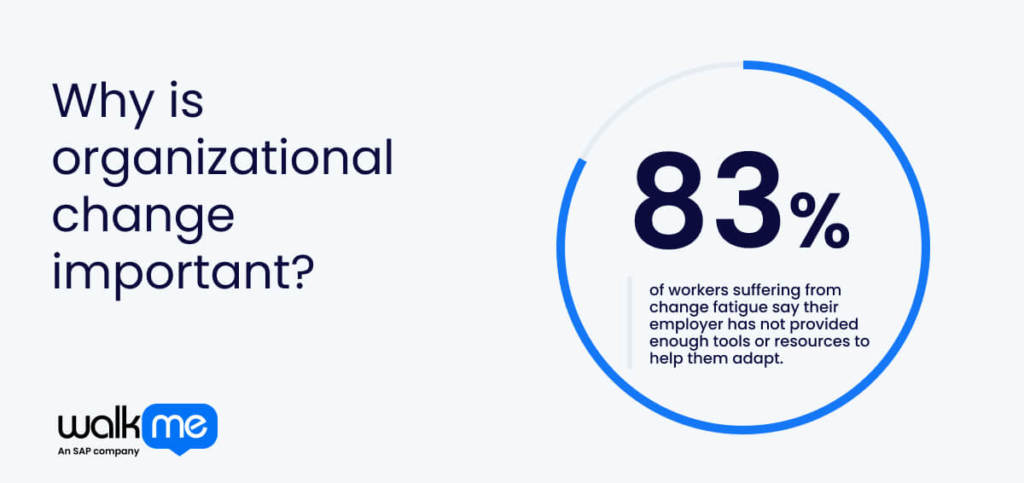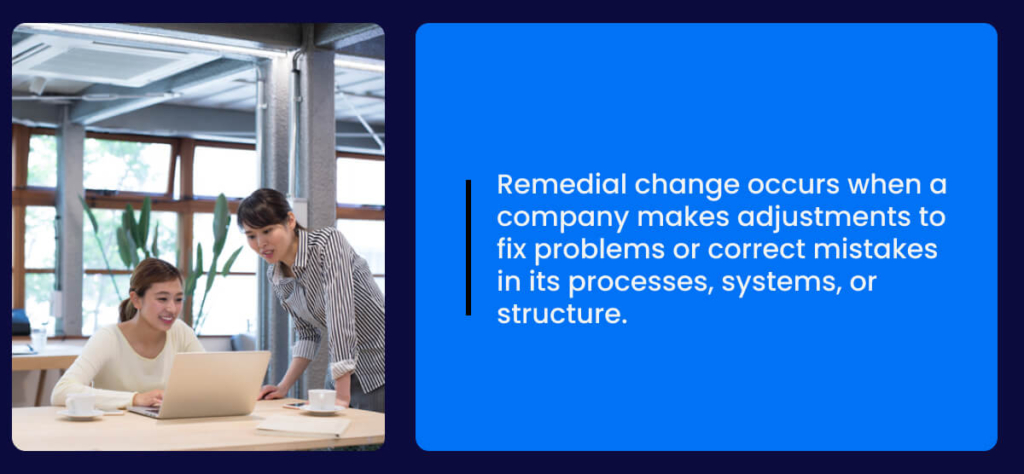Recognizing the 14 types of organizational change helps leaders understand the dynamics at play. It lets them anticipate obstacles and tailor strategies to align with each transformation’s unique demands.
This article explores the 14 types of organizational change to offer a framework for addressing challenges and achieving successful outcomes.
What is organizational change?
Organizational change is the transformation of a company’s structure, strategies, processes, or culture to adapt to internal or external shifts. Companies might also shift their technology or business practices to stay competitive.
For example, a traditional store moving online needs to retrain workers, update computer systems, and create new marketing approaches. Successful change requires leaders who help employees understand and adjust to new ways of working.
This means balancing technical updates with people’s reactions to those changes. The main goal is to keep the business flexible and ready to handle various situations.
Organizational change isn’t just about adopting digital tools. It’s about helping people work smarter and supporting the company’s growth.
Why is organizational change important?

Organizational change is important because it enables companies to adapt to evolving market conditions, customer expectations, and technological advancements.
Managing change fatigue is the top mission-critical priority for communication leaders.
Without updating their approach, businesses risk becoming irrelevant or losing ground to competitors. Organizational change allows organizations to optimize operations, improve efficiency, and drive digital innovation.
However, it’s not just about adjusting processes. It’s about aligning culture, leadership, and people with new goals. When done well, change helps organizations become more flexible and discover new opportunities.
Companies that resist change struggle to meet customer expectations and miss chances to grow and improve.
14 types of organizational change

This section will explore the 14 types of organizational change that address different aspects of transformation. It will help change leaders implement the right strategies for their unique challenges.
It’s important to understand that organizational change is in constant flux. This means that managers must remain flexible and adaptive. It also involves continually reassessing their approaches to ensure alignment with business needs and external factors.
Understanding the 14 types of organizational change provides leaders with insights into which approach best fits their situation. This allows them to drive transformation with purpose and minimize disruption.
Let’s explore the 14 types of organizational change:
- Organization-wide change
Organization-wide change refers to major shifts that affect how a company works, runs, or behaves. It involves revising strategies, processes, and roles to align with new goals or external demands.
Examples include company mergers, acquisitions, and even takeovers. Success depends on clear communication, leadership alignment, and employee engagement.
Companies implement changes that affect the entire organization to fix problems or keep up with the market. It’s important to plan carefully, thinking about both short-term disruptions and long-term results. Businesses often do this to stay competitive or successful over time.
- Transformational change
Transformational change involves deeply reshaping a company’s structure, culture, or operations to achieve long-term goals.
These changes go beyond small adjustments and aim to completely rethink how the business operates. For example, a company might start using brand-new technology, move into new markets, or shift its focus to a different purpose or mission.
Transformational change often comes with challenges, requiring strong leadership, a clear vision, and employee commitment. It is typically driven by the need to address major challenges or seize groundbreaking opportunities that traditional approaches might not be able to handle.
- Personnel change

Personnel change is when companies adjust their workforce to meet new business needs. This involves hiring new staff, moving people to different roles, or sometimes letting employees go.
Change happens because of shifting company goals, workload variations, or performance challenges. By bringing in new team members or redistributing roles, businesses can improve efficiency and introduce fresh skills and perspectives. These adjustments help companies stay competitive and tackle emerging challenges effectively.
Managers carefully plan these changes to minimize disruption and maintain team morale. While adapting to new team dynamics can be challenging, personnel changes are often necessary for a company’s growth. They help organizations remain agile and responsive to market demands.
- Incremental change
Incremental change is when businesses make small, careful improvements over time. Companies update their work methods bit by bit, like tweaking policies or slightly improving products.
These small changes help businesses stay competitive without causing big disruptions. Companies can respond to customer feedback and fix small issues by making minor adjustments. This approach allows organizations to grow and improve steadily, making continuous small steps instead of dramatic overhauls.
Employees and leaders collaborate to make small, meaningful changes that keep the business moving forward and adapting to new challenges.
- Unplanned change
Unplanned change happens when a company has to react quickly to unexpected events or challenges. These changes aren’t part of any planned strategy and often need fast decisions.
Examples include sudden economic shifts, losing key leaders, or natural disasters. Since there’s little time to prepare, unplanned change can be stressful and disruptive.
Companies need to be flexible, make quick decisions, and communicate well to handle these situations. While unplanned change can be tough, it can also highlight weaknesses in current systems and lead to new opportunities or improvements after the crisis is over.
- Remedial change

Remedial change occurs when a company makes adjustments to fix problems or correct mistakes in its processes, systems, or structure. These changes aim to address issues causing inefficiency, poor performance, or dissatisfaction.
Remedial change can involve process adjustments, retraining staff, or updating outdated systems. This type of change is usually reactive, driven by the need to address issues before they escalate.
While it can be disruptive in the short term, it helps the company get back on track and ensure that operations run smoothly. It’s about fixing what’s broken to prevent further issues.
- Structural change
Structural change involves major changes to a company’s organization, like how teams are set up or who reports to whom. It could mean creating new departments, merging existing ones, or changing leadership roles.
These changes often happen when a company needs to become more efficient, grow, or adjust its strategy. While it can shake things up, structural change helps a company improve its internal processes and better respond to new challenges or opportunities.
It’s about rethinking how the company is organized to work better overall. The most effective structural changes align the organization’s setup with its goals, making processes smoother and decision-making clearer.
- Technological change
Technological change happens when a company starts using new tools, systems, or software to improve its work. This might mean upgrading old machines, using better software, or automating tasks to make things faster and more accurate.
The main goals of technological change are to stay competitive, save money, or serve customers better. While new technology can cost money at first and require training, it helps the company in the long run by saving time and reducing mistakes.
Businesses must plan carefully, ensuring employees know how to use the new technology and understand its value.
- Cultural change
Cultural change in a company means changing the way people think, act, and interact with each other at work. It can involve shifting the company’s values, beliefs, and everyday behaviors.
For example, a company might move from a strict, top-down approach to one that encourages teamwork and open communication. Cultural change could also focus on promoting things like diversity, creativity, or a better balance between work and personal life.
This kind of change takes time because it’s about altering how people feel and behave on a daily basis. Strong leadership is also needed to guide this process and set an example for others.
- Strategic change
Strategic change happens when a company adjusts its main direction to reach long-term goals. This could include focusing on new markets, offering different products, or changing how the company operates to stay competitive.
Shifts in customer needs or new opportunities usually drive strategic change. It might also involve reorganizing the company or forming new partnerships.
This type of change is carefully planned to help the company grow and succeed in the future, making sure its strategy fits with new challenges and goals.
- Operational change
Operational change is about making adjustments to daily processes, systems, or structures to improve efficiency. This might include updating technology, improving workflows, or changing how tasks are managed.
These changes don’t affect a business’s main goals but make work smoother and faster. For example, a company might reorganize its customer service team to respond more quickly or use new software to help employees work together better.
While these changes seem small, they improve the company’s operations and help it work more effectively over time.
- Dynamic change
Dynamic change occurs when a company makes frequent and rapid changes to respond to external factors, such as new trends, customer needs, or technology.
These changes often come up unexpectedly and require the company to adjust quickly. For example, a company might change its products or services regularly to stay ahead of competitors or meet new demands.
Dynamic change occurs because businesses need to stay competitive and relevant in a constantly changing world. To drive dynamic change, a company must be flexible, make quick decisions, and be ready to switch direction when needed.
- Systems change
Systems change occurs when a company adjusts the core structures and processes that guide its operations. This could involve changing how information is shared, how tasks are assigned, or how departments collaborate.
It often includes adopting new tools, technologies, or methods to make the company more efficient. For example, a business might switch to a more effective software system for managing projects or reorganize teams to improve communication.
The aim of system change is to improve overall functionality, ensuring that operations run more smoothly and efficiently over time.
- Transitional change
Transitional change involves helping a company move from its current way of doing things to a new way. This kind of change often happens when a company needs to adapt to new challenges, such as changes in the market, technology, or business goals.
It could involve reorganizing teams, changing how work is done, or bringing in new tools and systems to support the shift. Transitional change is usually temporary and focuses on guiding the company through the shift, ensuring everything adjusts smoothly.
Once the transition is complete, the company stabilizes in its new direction or way of working.
How to ensure successful organizational change

Change is a constant. Ensuring successful organizational change requires continued research and investment in both people and processes to adapt effectively and stay ahead of challenges.
With that in mind, here is a list of key steps to ensure successful organizational change:
- Set goals and a strategy: Clearly define the goals and a plan for achieving them so everyone knows what’s expected.
- Overcome resistance: Involve employees early, listen to their concerns, and explain why the change is needed to get their support.
- Offer management support: Make sure leaders at all levels are committed to the change and provide clear guidance throughout the process.
- Provide training for new technologies: Offer training to help employees learn new tools and systems, making the transition easier.
- Invest in agility training: Teach employees to adapt quickly by improving skills like time management and resilience.
- Establish a change management team: Create a team to manage the change, track progress, and solve problems.
- Measure and celebrate success: Track progress and celebrate milestones to keep motivation high.
- Maintain communication: Keep everyone updated with clear, honest information to reduce uncertainty.
Mastering the 14 types of organizational change
Understanding the 14 types of organizational change is important for business leaders.
Each type of change, whether related to technology, culture, structure, or strategy, impacts businesses in different ways. Knowing which changes happen allows executives to make better decisions and effectively guide their teams.
This understanding helps prevent confusion or pushback, ensuring the change management process goes smoothly. In a world where things are always changing, managing different types of change helps companies remain flexible, grow, and stay ahead of the competition.
Recognizing the right changes at the right time leads to better business results.

